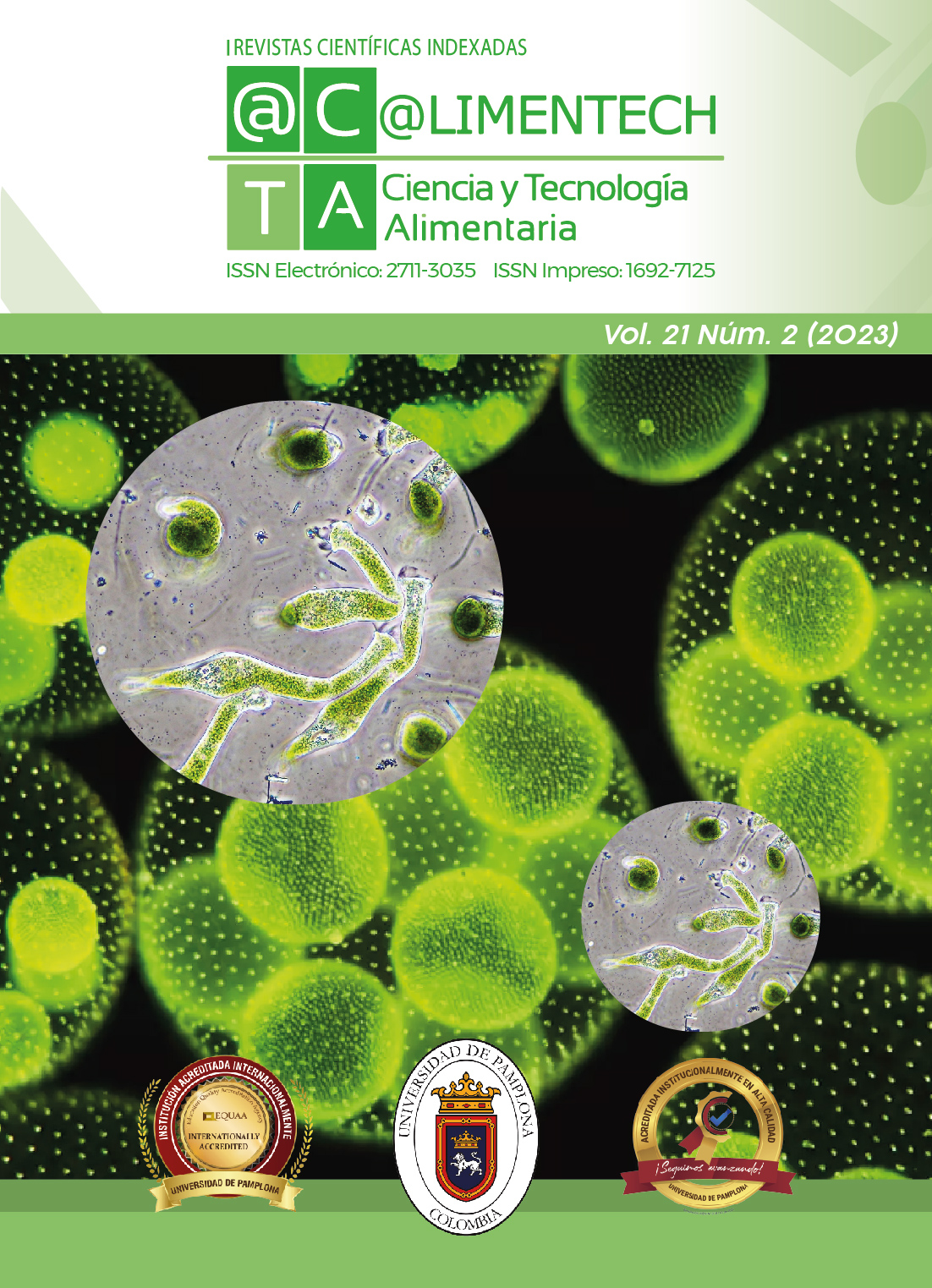Evaluación de condiciones higiénico-sanitarias en el servicio de alimentación de un centro educativo en la ciudad de Barranquilla en el periodo 2010-2022
DOI:
https://doi.org/10.24054/limentech.v21i2.2789Palabras clave:
Análisis microbiológico, Buenas Prácticas de Manufactura, ETA, Seguridad alimentariaResumen
Las enfermedades trasmitidas por alimentos (ETA) son el resultado de la ingestión de alimentos contaminados con
microorganismos patógenos o sus toxinas. Las ETA son un evento es de interés en salud pública debido a la carga
socioeconómica que representan por la afectación a la salud de la comunidad. Según estimaciones de la Organización
Mundial de Salud, los niños menores de cinco años y las personas de bajos recursos económicos son los más afectados. Entre las estrategias que se desarrollan para su prevención se encuentra la implementación de las Buenas Prácticas de Manufactura (BPM) por parte de los servicios de alimentación y a nivel domiciliario. Estudio descriptivo, de corte retrospectivo. Con la aplicación del perfil sanitario se calificaron los ítems requeridos. La puntuación final se basa según criterios evaluativos: No cumple: < 60% de puntaje, Cumple parcialmente: 60 a 79%, Satisfactorio: 80 a 91%, y Excelente: > 91 %. Se realizó análisis microbiológico de los alimentos preparados para evaluación de su conformidad. Durante el periodo estudiado se evidenció un cumplimiento parcial durante el 2010-2016, que evolucionó a satisfactorio para el 2017-2019 y 2022. Para la conformidad de los
alimentos preparados hubo una tendencia a la disminución de la aceptabilidad, que mejoró a partir del año 2017. El requisito
de aseguramiento y control de calidad inició con nulo cumplimiento y mejorando a la culminación del estudio. Los
resultados del estudio evidenciaron un aumento significativo en el cumplimiento de las BPM lo que manifiesta la efectividad de las estrategias implementadas.
Descargas
Referencias
Basto, L. (2017). Identificación de Listeria monocytogenes en alimentos suministrados en el sur del departamento del Tolima. Universidad del Tolima.
Cabrejos-Ugaz, C. T., & Chávarry-Ysla, P. D. R. (2020). Análisis sanitario de la industria de la panificación en el Perú. Revista @limentech, Ciencia y Tecnología Alimentaria, 18(1), 79-90.
FAO and WHO. (1999). Código Internacional recomendado de prácticas - Principios generales de higiene de los alimentos.
Fernández, S., Bu, J., Chávez, V., & Montoya, H. (2021). Enfermedades transmitidas por Alimentos (Etas): Una Alerta para el Consumidor. Ciencia Latina Revista Científica Multidisciplinaria, 5(2), 2284-2298. https://doi.org/10.37811/cl_rcm.v5i2.433
Forero, A., Galindo, M., & Morales, G. (2018). Aislamiento de Bacillus cereus en restaurantes escolares de Colombia. Biomédica, 38(3), 338-344. https://doi.org/10.7705/biomedica.v38i3.3802
Garcinuño Martínez, R. (2017). Contaminación de los alimentos durante los procesos de origen y almacenamiento. Aldaba, 36, 51-64. https://doi.org/10.5944/aldaba.36.2012.20530
Havelaar, A. (2019). Primera Conferencia Internacional FAO / OMS / UA sobre Inocuidad Alimentaria, Addis Abeba, 12 y 13 de febrero de 2019 Comunicación eficaz e interacción con el público en lo que respecta a temas de inocuidad y calidad de los alimentos en la era digital. 1-5.
Suescún Carrero, S., & Avila-Panche, S. (2017). Evaluación microbiológica en programas de alimentación escolar en instituciones educativas en el Departamento de Boyacá – Colombia. Nova, 15(28), 93. https://doi.org/10.22490/24629448.2084
Instituto Nacional de Medicamentos y Alimentos (INVIMA). (2018). Parámetros Microbiológicos. Colombia.
Instituto Nacional de Salud - MinSalud. (2020). Protocolo de Vigilancia en Salud Pública Investigación de brote Enfermedades Transmitidas por Alimentos y vehiculizadas por agua. Colombia.
Leal, L., Eedy, J., Lopez, M. J., Sánchez, C. Z., & Patiño, H. A. (2018). Censo y Diagnostico Higiénico Sanitario de los Expendios de Carne de Bovino del Municipio de Pamplona. Revista @limentech, Ciencia y Tecnología Alimentaria, 16(2), 68-82.
Madigan, M. (2015). Brock. Biología de los microorganismos. Pearson.
Ministerio de Salud y de la Protección Social de Colombia. (2009). Decreto 3518 de 2006. Gaceta Oficial, 93(S85), 22-70.
Ministerio de Salud. (2002). Por el cual se promueve la aplicación del Sistema de Análisis de Peligros y Puntos Críticos de Control (HACCP) en las fábricas de alimentos y se reglamenta el proceso de certificación. Gaceta Oficial, 2, 8.
Ministerio de Salud y de la Protección Social de Colombia. (2013). Resolución 2674 de 2013. Colombia.
Niño, H. L. A., Cáceres, N. K. L., & Sáenz, D. L. H. (2018). Situación nutricional de escolares beneficiarios de un programa de asistencia alimentaria en la ciudad de Cúcuta. Revista @limentech, Ciencia y Tecnología Alimentaria, 16(2), 18-31.
Organización de las Naciones Unidas para la Alimentación y la Agricultura (FAO). (2016). Manipuladores de Alimentos. Washington DC.
Pires, S., et al. (2015). Aetiology-specific estimates of the global and regional incidence and mortality of diarrhoeal diseases commonly transmitted through food. PLoS One, 10(12), 1-17. https://doi.org/10.1371/journal.pone.0142927
Vélez Castro, A. (2009). Asesoría, consultoría, auditoría y capacitación en calidad ¿cómo podemos definir la calidad e inocuidad alimentaria? Calidad Alimentaria, 1-3. Available at: www.calidadalimentaria.co
Zárate, A. (2018). Enfermedades Transmitidas por Alimentos, Colombia 2018. Bogotá D.C. Available at: https://www.ins.gov.co/buscadoreventos/Paginas/Info-Evento.aspx
Descargas
Publicado
Número
Sección
Licencia
Derechos de autor 2023 @limentech, Ciencia y Tecnología Alimentaria

Esta obra está bajo una licencia internacional Creative Commons Atribución-NoComercial 4.0.








